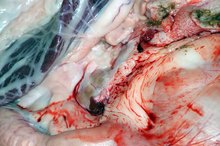When that Burning Sensation in Your Stomach is a Sign of Stomach Ulcers
Stomach ulcers are painful sores on your stomach lining that are can be caused by bacteria or certain medications. If you're experiencing a burning sensation and pain in your upper abdomen, you just might have an ulcer. But spicy foods and emotional stress aren’t the culprits, like some people believe.
If you are experiencing serious medical symptoms, seek emergency treatment immediately.
What Is a Stomach Ulcer?
“Stomach ulcers are breaks in the inner lining of the stomach,” says Patricia Raymond, MD, a gastroenterologist with Sentara Princess Anne Hospital in Virginia Beach.
Your stomach is made up of layers of tissue, and the inner lining of your stomach is protected by a thick layer of mucus, the Cleveland Clinic points out 15. But when this mucus coating erodes, the stomach lining is left exposed to stomach acid, and stomach ulcers can develop, according to the National Institute of Diabetes and Digestive and Kidney Diseases (NIDDK) 2.
What Causes Stomach Ulcers?
Can Coffee Trigger Stomach Virus Symptoms?
Learn More
Spicy foods and stress in your life do not cause ulcers, although they can make symptoms worse, according to the Mayo Clinic 125. Instead, the NIDDK says, microscopic organisms called Helicobacter pylori (H. Pylori) are usually to blame 3. The spiral-shaped bacteria enter your body and damage the mucus, Mayo Clinic explains 13. Once H. pylori have broken the protective coating, stomach acid can irritate the lining of your stomach.
It’s not exactly clear how H. pylori infects people. The bacteria are thought to be passed via contaminated water or contact with an infected person’s saliva, feces or vomit, the Mayo Clinic says 1. People often don't know they've been infected because most people have no symptoms.
Stomach ulcers also can be caused by overuse of nonsteroidal anti-inflammatory drugs (NSAIDs), such as Advil, Motrin IB and others, the Mayo Clinic adds 1.
Read more: What Can I Eat and Drink with a Peptic Ulcer?
- Spicy foods and stress in your life do not cause ulcers, although they can make symptoms worse, according to the Mayo Clinic.
What Does a Stomach Ulcer Feel Like?
Less common symptoms of a stomach ulcer are a feeling of fullness, burping, fatty food intolerance, heartburn, nausea, loss of appetite, vomiting and weight loss, the Mayo Clinic says 1.cause:
- Less common symptoms of a stomach ulcer are a feeling of fullness
- burping
- fatty food intolerance
- heartburn
- nausea
- loss of appetite
- vomiting
- weight loss
- the Mayo Clinic says 1
Without treatment, these symptoms can get worse. Alcohol, caffeine, spicy foods and cigarettes can also irritate ulcers and make symptoms worse.
When Should You See a Doctor?
What Is Duodenum Erosion?
Learn More
Bleeding from an ulcer can also happen, according to the Mayo Clinic 1. However, bleeding is often slow and may go unnoticed until the person becomes anemic because they don't have enough healthy red blood cells. Anemia symptoms include fatigue, shortness of breath and, for some, a pale skin color.
If you feel weak or faint; have difficulty breathing; notice blood in your stool or vomit; or feel sudden, sharp stomach pains, the NIDDK urges you to seek immediate medical attention. If your over-the-counter antacids and acid blockers relieve pain, but the pain returns, that’s also a sign to see your doctor. These are red flags that a stomach ulcer may have caused something more serious.
"To treat an ulcer, doctors have to detect and eradicate H. pylori, buffer stomach acid with caustic medications and eliminate gastric acid with medications," says Dr. Raymond. Treatment for ulcers is usually helpful, with medication helping the ulcers to heal over time. But to minimize discomfort, it’s also best to avoid foods that cause you consistent irritation.
Read more: Foods to Avoid When You Have a Stomach Ulcer
- Bleeding from an ulcer can also happen, according to the Mayo Clinic 1.
- However, bleeding is often slow and may go unnoticed until the person becomes anemic because they don't have enough healthy red blood cells.
Related Articles
References
- Mayo Clinic: “Peptic Ulcer”
- National Institute of Diabetes and Digestive and Kidney Diseases: “Symptoms & Causes of Peptic Ulcers”
- Mayo Clinic: “Helicobacter Pylori (H. pylori) infection”
- Advances in Health Science Research: “Helicobacter Pylori Infection in Children”
- Cleveland Clinic: "Peptic Ulcer Disease"
- Saljoughian M. Gastrointestinal Bleeding: An Alarming Sign. US Pharm. 2009;34(12):HS12-HS16.
- Ramakrishnan K, Salinas RC. Peptic ulcer disease. Am Fam Physician. 2007;76(7):1005-12.
- Azhari H, Underwood F, King J, et al. A36 THE GLOBAL INCIDENCE OF PEPTIC ULCER DISEASE AND ITS COMPLICATIONS AT THE TURN OF THE 21ST CENTURY: A SYSTEMATIC REVIEW. Journal of the Canadian Association of Gastroenterology. 2018;1(2):61-62. doi:10.1093/jcag/gwy009.036
- Malik TF, Singh K. Peptic Ulcer Disease. StatPearls Publishing. Updated December 4, 2018.
- Nelms DW, Pelaez CA. The Acute Upper Gastrointestinal Bleed. Surg Clin North Am. 2018;98(5):1047-1057. doi:10.1016/j.suc.2018.05.004
- Saljoughian M. Gastrointestinal Bleeding: An Alarming Sign. US Pharm. 2009;34(12):HS12-HS16.
- Testerman TL, Morris J. Beyond the stomach: an updated view of Helicobacter pylori pathogenesis, diagnosis, and treatment. World J Gastroenterol. 2014;20(36):12781-808. doi:10.3748/wjg.v20.i36.12781
- American College of Gastroenterology. Peptic Ulcer Disease.
- Vomero ND, Colpo E. Nutritional care in peptic ulcer. Arq Bras Cir Dig. 2014;27(4):298-302. doi:10.1590/S0102-67202014000400017
- Lau JY, Sung J, Hill C, et al. Systematic Review of the Epidemiology of Complicated Peptic Ulcer Disease: Incidence, Recurrence, Risk Factors and Mortality. Digestion, 2011; 84:102. doi:10.1159/000323958
- Li LF, Chan RL, Lu L, et al. Cigarette Smoking and Gastrointestinal Diseases: the Causal Relationship and Underlying Molecular Mechanisms (Review). Int J Mol Med,2014; 34:372. doi:10.3892/ijmm.2014.1786
- Malfertheiner P, Megraud F, O'Morain CA, et al. Management of Helicobacter Pylori Infection--the Maastricht IV/ Florence Consensus Report. Gut, 2012; 61:646. doi:10.1136/gutjnl-2012-302084








